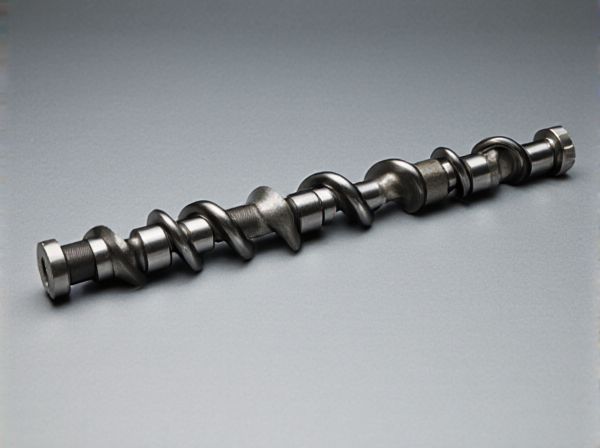
Photo illustration: Flat Tappet vs Roller Tappet Camshaft
Flat tappet camshafts rely on a sliding contact surface that requires proper lubrication to prevent wear, making them more susceptible to cam lobe damage under high-stress conditions. Roller tappet camshafts feature rolling elements that reduce friction and improve durability, offering better performance and longer lifespan for Your engine. Choosing between flat tappet and roller tappet cams depends on factors such as engine design, application, and maintenance preferences.
Table of Comparison
| Feature | Flat Tappet Camshaft | Roller Tappet Camshaft |
|---|---|---|
| Design | Flat tappet lifters with a flat contact surface | Roller lifters with a rotating wheel to reduce friction |
| Friction | Higher friction due to sliding contact | Lower friction, improved efficiency |
| Durability | Subject to wear; requires specific break-in procedures | More durable, longer lifespan |
| Performance | Standard horsepower, limited by friction losses | Enhanced horsepower and torque due to better timing control |
| Cost | Generally less expensive | Higher initial cost |
| Maintenance | Requires regular inspection and potential lifter replacement | Lower maintenance needs |
| Compatibility | Common in older engine designs | Popular in modern performance and racing engines |
Introduction to Camshaft Tappets
Camshaft tappets are crucial components in an internal combustion engine, controlling the timing and lift of the valves by translating rotational motion into linear movement. Flat tappet camshafts use a sliding contact surface between the tappet and the cam lobe, creating more friction and requiring specific lubrication to prevent wear. Roller tappet camshafts incorporate a small roller bearing that reduces friction and wear, allowing for more aggressive cam profiles and improved engine performance.
What Is a Flat Tappet Camshaft?
A flat tappet camshaft features lifters with a flat surface that rides directly on the camshaft lobes, providing precise valve timing in classic and older engine designs. This camshaft type relies on proper lubrication and break-in procedures to prevent wear due to the increased friction between flat tappet lifters and cam lobes. Flat tappet camshafts are favored for their cost-effectiveness and simplicity but require high-quality oils containing zinc dialkyldithiophosphate (ZDDP) for optimal performance and durability.
What Is a Roller Tappet Camshaft?
A roller tappet camshaft features cam lobes that push roller lifters equipped with small wheels, significantly reducing friction compared to flat tappet camshafts that slide directly on the cam lobes. This design enhances durability and allows for more aggressive cam profiles, resulting in improved engine performance and efficiency. Roller tappet camshafts are especially favored in high-performance and modern engines for their ability to reduce wear and increase valve train responsiveness.
Key Differences Between Flat and Roller Tappets
Flat tappet camshafts use a flat surface that slides over the lifter, creating more friction and requiring higher-quality oil for durability, whereas roller tappet camshafts utilize a roller bearing that reduces friction and wear, enhancing efficiency and lifespan. Roller tappets allow for more aggressive cam profiles due to their reduced friction and improved valvetrain control, leading to better performance compared to flat tappets. The choice impacts maintenance requirements, engine noise, and overall valve train longevity, with roller tappet systems generally preferred for high-performance and modern engines.
Performance Comparison: Flat vs Roller Tappet
Roller tappet camshafts offer superior performance due to reduced friction and wear compared to flat tappet camshafts, resulting in higher efficiency and longer engine life. Flat tappet camshafts generate more friction, which can cause higher heat and increased engine wear under high RPM conditions. The roller design allows for more aggressive cam profiles, improving valve lift and timing precision, leading to enhanced horsepower and torque output.
Advantages of Flat Tappet Camshafts
Flat tappet camshafts offer a simpler design with fewer moving parts, resulting in lower cost and easier maintenance compared to roller tappet camshafts. They provide excellent wear resistance when paired with proper lubrication and quality camshaft materials, making them a durable choice for classic and budget engines. Their compact profile is ideal for engines with limited space, supporting straightforward installation and reliable valve timing performance.
Benefits of Roller Tappet Camshafts
Roller tappet camshafts reduce friction by utilizing rolling elements instead of sliding contact, resulting in improved engine efficiency and reduced wear. The precise valve timing enabled by roller tappets enhances performance and allows higher RPM limits, making them ideal for high-performance and racing engines. Additionally, roller tappet camshafts contribute to longer engine life and decreased maintenance costs due to their durability and smoother operation.
Common Issues with Flat Tappet Cams
Flat tappet camshafts commonly face issues such as excessive wear and pitting due to inadequate lubrication and the high contact stress between the tappet and cam lobe. This wear can lead to reduced engine performance, increased noise, and shorter camshaft lifespan compared to roller tappet cams, which use roller bearings to minimize friction. Proper oiling techniques and high-quality flat tappet camshafts can mitigate these problems, but they remain a significant concern in classic and budget engine builds.
Maintenance and Lifespan Considerations
Flat tappet camshafts require more frequent maintenance due to increased wear rates and the necessity of proper oil additives to prevent metal-to-metal contact, which can accelerate degradation. Roller tappet camshafts offer extended lifespan and reduced maintenance intervals because their roller bearings minimize friction and wear, improving durability in high-performance and daily driving applications. Choosing a roller tappet camshaft can significantly lower long-term engine maintenance costs and enhance reliability.
Choosing the Right Camshaft for Your Engine
Selecting the right camshaft for your engine depends heavily on the type of tappet system: flat tappet or roller tappet. Flat tappet camshafts provide simpler, cost-effective durability but require precise break-in and quality lubrication to prevent wear, making them suited for older or low-performance engines. Roller tappet camshafts deliver higher lift and more aggressive profiles with reduced friction and increased efficiency, making them ideal for modern, high-performance builds aiming for maximum power and longevity.
 caratoz.com
caratoz.com